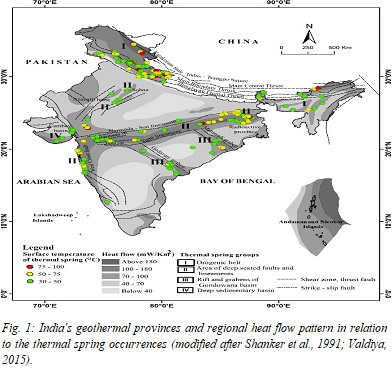 The widely distributed thermal springs in India are reviewed from a hydrogeochemical and isotopic perspective. Based on the geotectonic framework, the thermal springs are classified into four groups: (a) Orogenic belt, (b) Areas of deep-seated faults and lineaments, (c) Rifts and grabens of Gondwana basin and (d) Deep sedimentary basin. Detailed investigations over the last few decades culminated in the development of a vast geochemical database for thermal springs and associated gaseous phases, which are now available online since the late 1960s. After a careful evaluation of their quality and reliability, these data have been used in this study. Representative datasets of thermal spring waters from each group and subgroup have been evaluated following a classical approach, including water classifications, use of the triangular diagrams, geothermometric estimates and isotopic signatures that identified significant hydrogeochemical variations among different thermal spring clusters. Differences in rock-water interactions, and system characteristics such as water source, heat source, and topographic relief, were found to be the causes of observed variations. Thermal springs near the coast of western India have a high Cl content relative to Na, indicating that they have been influenced by seawater. Most thermal springs in the northern territory have high HCO3 and low Cl, suggesting that they have mixed with HCO3-rich near-surface water. Due to their emergence from the Precambrian crystallines, most thermal springs in the central and eastern part of India are distributed within the Na-Cl and Na-Cl-HCO3 type facies with low SO4 content. Different geochemical thermometers such as silica, cation thermometers, and a combination of silica K-Mg systems were used to estimate reservoir temperatures, resulting in a temperature range of roughly 60–140°C. Because of the lack of equilibrium, the values of reservoir temperatures between 200°C and 300°C obtained using Na-K geothermometers may not be reliable. In general, the reservoir temperatures for thermal springs in India's northern and eastern parts are greater than those located in the southern and western continental margins. The chemistry of the associated gaseous discharges is dominated by atmospheric components. The exceptions are thermal springs from the Orogenic belt of Himalaya that are enriched with CO2 possibly sourced from metamorphic decarbonation. The 3He/4He isotopic ratio in the gaseous discharge across all the groups and subgroups predominantly bears signatures of crustal origin. Stable isotopic signatures strongly suggest that these hydrothermal systems are predominantly recharged by local meteoric waters. In contrast, a discernible positive oxygen-isotopic shift in thermal waters indicates the existence of high enthalpy reservoirs in the NW Himalayan region. With the exception of a few springs, long circulation time (>50 years) of meteoric waters within the conduit is indicated by low tritium values in the thermal waters.
The widely distributed thermal springs in India are reviewed from a hydrogeochemical and isotopic perspective. Based on the geotectonic framework, the thermal springs are classified into four groups: (a) Orogenic belt, (b) Areas of deep-seated faults and lineaments, (c) Rifts and grabens of Gondwana basin and (d) Deep sedimentary basin. Detailed investigations over the last few decades culminated in the development of a vast geochemical database for thermal springs and associated gaseous phases, which are now available online since the late 1960s. After a careful evaluation of their quality and reliability, these data have been used in this study. Representative datasets of thermal spring waters from each group and subgroup have been evaluated following a classical approach, including water classifications, use of the triangular diagrams, geothermometric estimates and isotopic signatures that identified significant hydrogeochemical variations among different thermal spring clusters. Differences in rock-water interactions, and system characteristics such as water source, heat source, and topographic relief, were found to be the causes of observed variations. Thermal springs near the coast of western India have a high Cl content relative to Na, indicating that they have been influenced by seawater. Most thermal springs in the northern territory have high HCO3 and low Cl, suggesting that they have mixed with HCO3-rich near-surface water. Due to their emergence from the Precambrian crystallines, most thermal springs in the central and eastern part of India are distributed within the Na-Cl and Na-Cl-HCO3 type facies with low SO4 content. Different geochemical thermometers such as silica, cation thermometers, and a combination of silica K-Mg systems were used to estimate reservoir temperatures, resulting in a temperature range of roughly 60–140°C. Because of the lack of equilibrium, the values of reservoir temperatures between 200°C and 300°C obtained using Na-K geothermometers may not be reliable. In general, the reservoir temperatures for thermal springs in India's northern and eastern parts are greater than those located in the southern and western continental margins. The chemistry of the associated gaseous discharges is dominated by atmospheric components. The exceptions are thermal springs from the Orogenic belt of Himalaya that are enriched with CO2 possibly sourced from metamorphic decarbonation. The 3He/4He isotopic ratio in the gaseous discharge across all the groups and subgroups predominantly bears signatures of crustal origin. Stable isotopic signatures strongly suggest that these hydrothermal systems are predominantly recharged by local meteoric waters. In contrast, a discernible positive oxygen-isotopic shift in thermal waters indicates the existence of high enthalpy reservoirs in the NW Himalayan region. With the exception of a few springs, long circulation time (>50 years) of meteoric waters within the conduit is indicated by low tritium values in the thermal waters.
Bibliographic Info: Prasenjit Das, Maya, K., Padmalal, D. [2021]. Hydrogeochemistry of the Indian thermal springs: Current status. Earth-Science Reviews, Vol. 224, Art. 103890. https://doi.org/10.1016/j.earscirev.2021.103890




 RTI Act
RTI Act
